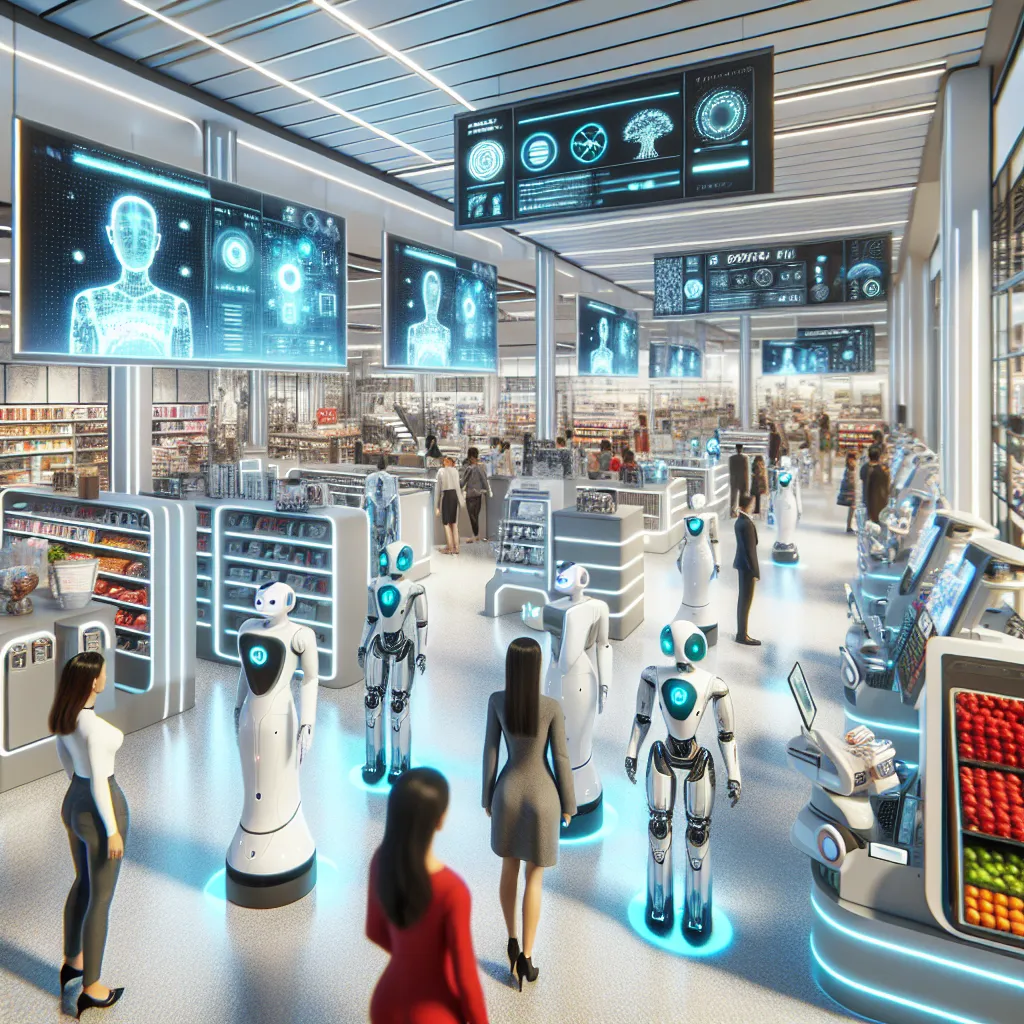As an experienced IELTS instructor, I’m excited to share a comprehensive reading practice test focused on the transformative impact of automation in the retail sector. This test will help you prepare for the IELTS Reading module while exploring a fascinating topic that’s reshaping our shopping experiences.
 Retail Automation Technology
Retail Automation Technology
Introduction to the Test
Today’s IELTS Reading practice test revolves around the theme “How automation is transforming the retail industry.” This topic is not only relevant for the IELTS exam but also provides insights into the rapidly evolving retail landscape. The test consists of three passages of increasing difficulty, mirroring the actual IELTS Reading test structure.
Passage 1 (Easy Text)
The Rise of Retail Automation
Retail automation has become a cornerstone of modern shopping experiences. From self-checkout kiosks to inventory management systems, technology is reshaping how we buy and sell goods. This transformation is not just about replacing human workers; it’s about enhancing efficiency, improving customer experiences, and adapting to changing consumer behaviors.
One of the most visible forms of retail automation is the self-checkout system. These kiosks allow customers to scan, bag, and pay for their items without interacting with a cashier. While initially met with skepticism, self-checkout has become increasingly popular, especially among younger shoppers who value speed and autonomy in their shopping experiences.
Behind the scenes, automation plays an even larger role. Inventory tracking systems use RFID tags and sophisticated software to monitor stock levels in real-time, ensuring that popular items are always available while reducing waste from overstocking. This technology has revolutionized supply chain management, allowing retailers to respond more quickly to consumer demands and market trends.
Another area where automation shines is in personalized marketing. By analyzing vast amounts of customer data, retailers can now tailor promotions and product recommendations to individual shoppers. This level of personalization was once impossible but is now becoming the norm, thanks to advanced algorithms and machine learning.
However, the rise of automation in retail is not without challenges. Concerns about job displacement and the need for workers to acquire new skills are ongoing issues. Additionally, there are concerns about data privacy and the potential for technical glitches to disrupt shopping experiences.
Despite these challenges, the trend towards greater automation in retail shows no signs of slowing. As technology continues to advance, we can expect even more innovative solutions that will further transform the shopping experience for consumers and retailers alike.
Questions 1-5
Do the following statements agree with the information given in the passage?
Write:
TRUE if the statement agrees with the information
FALSE if the statement contradicts the information
NOT GIVEN if there is no information on this
- Self-checkout systems are universally preferred by all age groups.
- RFID tags are used in inventory management systems.
- Personalized marketing relies on customer data analysis.
- Automation in retail has eliminated the need for human workers entirely.
- Technical issues can potentially disrupt automated shopping experiences.
Questions 6-10
Complete the sentences below.
Choose NO MORE THAN TWO WORDS from the passage for each answer.
- Self-checkout kiosks allow customers to complete their purchases without interacting with a ____.
- ____ ____ systems have revolutionized how retailers manage their stock.
- Personalized marketing and product recommendations are made possible by ____ ____ and machine learning.
- One of the main concerns about retail automation is potential ____ ____.
- Despite challenges, the trend towards automation in retail is expected to ____.
Passage 2 (Medium Text)
The Impact of E-commerce Automation
The e-commerce revolution has been a driving force behind the automation of retail processes. Online shopping platforms have leveraged technology to create seamless, efficient, and personalized shopping experiences that traditional brick-and-mortar stores are now striving to emulate.
One of the most significant impacts of e-commerce automation is in the realm of customer service. Chatbots and virtual assistants powered by artificial intelligence (AI) are now capable of handling a wide range of customer inquiries, from product recommendations to order tracking. These AI-driven solutions can operate 24/7, providing instant responses to customers and freeing up human staff to handle more complex issues.
Furthermore, e-commerce platforms have pioneered the use of predictive analytics to forecast consumer behavior and optimize inventory management. By analyzing vast amounts of data on past purchases, browsing history, and even external factors like weather patterns or economic indicators, these systems can predict future demand with remarkable accuracy. This capability allows retailers to stock the right products in the right quantities, reducing waste and improving profitability.
Another area where automation has made significant inroads is in order fulfillment and logistics. Automated warehouses equipped with robots and conveyor systems can process orders much faster and more accurately than human workers alone. Some advanced facilities can pick, pack, and ship an order within minutes of it being placed online.
The automation of pricing strategies has also become increasingly sophisticated. Dynamic pricing algorithms can adjust product prices in real-time based on factors such as demand, competitor pricing, and even the individual customer’s purchasing history. This level of price optimization was once the domain of skilled human analysts but is now largely automated.
However, the rapid advancement of e-commerce automation has also raised concerns. The digital divide between tech-savvy consumers and those less comfortable with technology risks leaving some shoppers behind. Additionally, the vast amount of personal data collected and analyzed by these systems has sparked debates about privacy and data security.
Despite these challenges, the automation of e-commerce continues to accelerate. As technologies like augmented reality (AR) and virtual reality (VR) become more mainstream, we can expect even more innovative applications in online retail, further blurring the lines between physical and digital shopping experiences.
Questions 11-14
Choose the correct letter, A, B, C, or D.
-
According to the passage, chatbots and virtual assistants in e-commerce:
A) Have completely replaced human customer service representatives
B) Can only handle basic customer inquiries
C) Operate round the clock to assist customers
D) Are less efficient than human staff -
Predictive analytics in e-commerce is used primarily to:
A) Increase product prices
B) Optimize inventory management
C) Design new products
D) Train customer service staff -
Automated warehouses in e-commerce are notable for their:
A) High error rates
B) Slow processing times
C) Reliance on human workers
D) Speed and accuracy in order processing -
The digital divide in e-commerce refers to:
A) The gap between online and offline sales
B) Differences in internet speeds across regions
C) The disparity between tech-savvy and less tech-comfortable consumers
D) The price difference between physical and online stores
Questions 15-20
Complete the summary below.
Choose NO MORE THAN TWO WORDS from the passage for each answer.
E-commerce automation has revolutionized retail in several key areas. (15) ____ ____ powered by AI can now handle many customer service tasks. Retailers use (16) ____ ____ to forecast consumer behavior and manage inventory effectively. In warehouses, (17) ____ and conveyor systems have greatly improved order processing efficiency. (18) ____ ____ algorithms allow for real-time price adjustments based on various factors. However, concerns exist about the (19) ____ ____ and data security implications of these technologies. Despite challenges, e-commerce automation continues to advance, with technologies like (20) ____ ____ (AR) expected to further innovate the online shopping experience.
Passage 3 (Hard Text)
The Socioeconomic Implications of Retail Automation
The inexorable march of automation in the retail sector is reshaping not just how we shop, but also the very fabric of our economic and social structures. This transformation, while promising increased efficiency and novel consumer experiences, also heralds a sea change in employment patterns and societal norms that warrants careful consideration.
At the forefront of this revolution is the potential for significant job displacement. Roles that have traditionally been the backbone of the retail workforce – cashiers, stock clerks, and customer service representatives – are increasingly being supplanted by automated systems. A study by the McKinsey Global Institute suggests that up to 800 million jobs worldwide could be automated by 2030, with retail being one of the most affected sectors. This shift raises pressing questions about the future of work and the need for comprehensive retraining programs to equip workers with the skills required in an automated retail landscape.
However, it would be myopic to view this transformation solely through the lens of job losses. Automation is also creating new categories of employment, particularly in the realms of data analysis, software development, and robotics maintenance. These roles often demand higher levels of education and technical skills, potentially leading to better-paying jobs for those who can adapt. Moreover, the increased efficiency brought about by automation could lead to lower prices for consumers, potentially stimulating economic growth through increased purchasing power.
The socioeconomic stratification resulting from retail automation is another area of concern. As high-skill, high-wage jobs in the sector become more prevalent, there is a risk of exacerbating income inequality. Those unable to transition to these new roles may find themselves relegated to lower-paying service jobs or face long-term unemployment. This scenario could lead to increased social tensions and put additional strain on social safety nets.
From a consumer perspective, the automation of retail promises a more personalized and frictionless shopping experience. Predictive algorithms can anticipate needs and preferences with uncanny accuracy, while automated logistics systems ensure rapid delivery. However, this convenience comes at the cost of increased data collection and analysis, raising significant privacy concerns. The potential for this data to be used for purposes beyond improving the shopping experience – such as influencing consumer behavior or even manipulating political opinions – is a growing ethical concern.
The environmental impact of retail automation is also a subject of debate. On one hand, optimized inventory management and more efficient logistics could reduce waste and lower carbon emissions. Conversely, the increased convenience of online shopping and rapid delivery services might lead to more frequent purchases and higher overall consumption, potentially negating any environmental benefits.
As we navigate this paradigm shift, policymakers face the challenge of balancing the economic benefits of automation with its social costs. Potential policy responses range from universal basic income schemes to mitigate job losses, to stricter regulations on data collection and use. Education systems will need to evolve to equip future generations with the skills needed to thrive in an automated economy.
In conclusion, the automation of retail represents a double-edged sword. While it promises increased efficiency, personalization, and potentially new categories of employment, it also poses significant challenges in terms of job displacement, privacy, and socioeconomic equity. As this transformation unfolds, it will be crucial for all stakeholders – retailers, consumers, workers, and policymakers – to engage in an ongoing dialogue to ensure that the benefits of automation are broadly shared and its challenges thoughtfully addressed.
Questions 21-26
Complete the sentences below.
Choose NO MORE THAN TWO WORDS from the passage for each answer.
- The McKinsey Global Institute predicts that up to 800 million jobs could be ____ by 2030.
- Automation in retail is creating new job categories in fields such as data analysis and ____ ____.
- The transition to high-skill jobs in retail may lead to increased ____ ____.
- Automated retail systems use ____ ____ to anticipate consumer needs and preferences.
- The convenience of automated retail comes with concerns about data ____ and analysis.
- Policymakers must balance the ____ ____ of automation with its social costs.
Questions 27-30
Do the following statements agree with the claims of the writer in the passage?
Write:
YES if the statement agrees with the claims of the writer
NO if the statement contradicts the claims of the writer
NOT GIVEN if it is impossible to say what the writer thinks about this
- Retail automation will inevitably lead to a net loss of jobs in the sector.
- The environmental impact of retail automation is definitively positive.
- Universal basic income is presented as a potential policy response to job displacement.
- The author believes that the challenges of retail automation outweigh its benefits.
Answer Key
Passage 1
- FALSE
- TRUE
- TRUE
- FALSE
- TRUE
- cashier
- Inventory tracking
- advanced algorithms
- job displacement
- continue
Passage 2
- C
- B
- D
- C
- Virtual assistants
- predictive analytics
- robots
- Dynamic pricing
- digital divide
- augmented reality
Passage 3
- automated
- software development
- income inequality
- predictive algorithms
- collection
- economic benefits
- NO
- NO
- YES
- NOT GIVEN
Conclusion
This IELTS Reading practice test on “How automation is transforming the retail industry” provides a comprehensive exploration of this crucial topic. By practicing with tests like these, you’ll not only improve your reading skills but also gain valuable insights into important global trends. Remember to analyze your performance and focus on areas that need improvement. For more practice and tips on acing the IELTS Reading module, check out our other resources on how AI is transforming the retail industry and the impact of technology on job automation.
Keep practicing, stay curious, and best of luck with your IELTS preparation!


